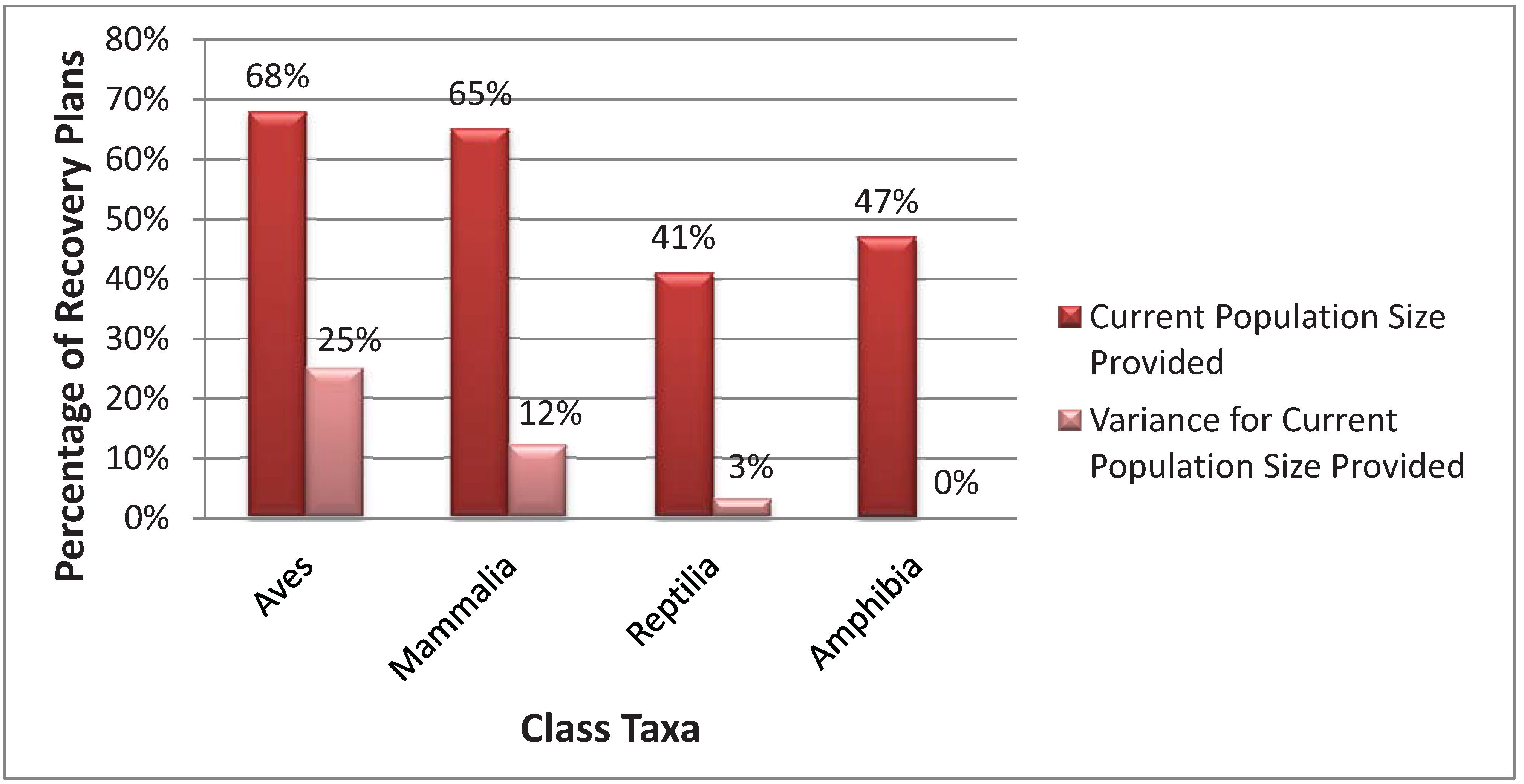Uncertainty in Population Estimates for Endangered Animals and Improving the Recovery Process
Abstract
:Simple Summary
Abstract
1. Introduction
2. Experimental Section
3. Results and Discussion
3.1. By the Numbers


3.2. Improving Recovery

4. Conclusions
Acknowledgments
Conflict of Interest
References and Notes
- ESA (Endangered Species Act); Public Law No. 93-205; NOAA Fisheries Service: Silver Spring, MD, USA, 1973.
- U.S. Fish and Wildlife Service. Policy and Guidelines for planning and coordinating recovery of endangered and threatened species. United States Department of the Interior Government Report. 1990. Available online: http://www.fws.gov/endangered/pdfs/Recovery/90guide.pdf (assessed on 1 October 2012).
- U.S. Fish and Wildlife Service. Threatened and Endangered Species System [TESS]. 2013. Available online: http://ecos.fws.gov/tess_public/ (assessed on 28 May 2013).
- Gerber, L.R.; Hatch, L.T. Are we recovering? An evaluation of recovery criteria under the US Endangered Species Act. Ecol. App. 2002, 12, 668–673. [Google Scholar] [CrossRef]
- Sanderson, E.W. How many animals do we want to save? The many ways of setting population target levels for conservation. BioScience 2006, 56, 911–922. [Google Scholar] [CrossRef]
- Tear, T.H.; Kareiva, P.; Angermeier, P.L.; Comer, P.; Czech, B.; Kautz, R.; Landon, L.; Mehlman, D.; Murphy, K.; Ruckelshaus, M.; Scott, J.M; Wilhere, G. How much is enough? The recurrent problem of setting measurable objectives in conservation. BioScience 2005, 55, 835–949. [Google Scholar] [CrossRef]
- Tear, T.H.; Scott, J.M.; Hayward, P.H.; Griffith, B. Status and Prospects for Success of the Endangered Species Act: A Look at the Recovery Plans. Science 1993, 262, 976–977. [Google Scholar]
- Tear, T.H.; Scott, J.M.; Hayward, P.H.; Griffith, B. Recovery Plans and the Endangered Species Act: Are Criticisms Supported by Data? Conserv. Conserv. Biol. 1995, 9, 182–194. [Google Scholar]
- Scott, J.M.; Tear, T.H.; Mills, L.S. Socioeconomics and the recovery of endangered species: Biological assessment in a political world. Conserv. Biol. 1995, 9, 214–216. [Google Scholar]
- Pauly, D. Anecdotes and the shifting baseline syndrome of fisheries. Trends Ecol. Evol. 1995, 10, 430. [Google Scholar] [CrossRef]
- Minitab 16 Statistical Software; Minitab, Inc.: State College, PA, USA, 2010.
- Crouse, D.T.; Mehrhoff, L.A.; Parkin, M.J; Elam, D.R.; Chen, L.Y. Endangered species recovery and the SCB study: A U.S. fish and wildlife service perspective. Ecol. Appl. 2002, 12, 719–723. [Google Scholar] [CrossRef]
- Recovery Plan for the Marbled Murrelet; U.S. Fish and Wildlife Service: Portland, OR, USA, 1997.
- Zar, J.H. Biostatistical Analysis; Prentice Hall: Upper Saddle River, NJ, USA, 1984. [Google Scholar]
- Canadian Wildlife Service; U.S. Fish and Wildlife Service. International Recovery Plan for the Whooping Crane; Recovery of Nationally Endangered Wildlife (RENEW): Ottawa, ON, Canada; U.S. Fish and Wildlife Service: Albuquerque, NM, USA, 2007.
- Clark, A.J.; Hoekstra, J.M.; Boersma, P.D.; Kareiva, P. Improving U.S. Endangered species recovery plans: Key findings and recommendations of the SCB recovery plan project. Conserv. Biol. 2002, 16, 1510–1519. [Google Scholar] [CrossRef]
- Boersma, P.D.; Kareiva, P.; Fagan, W.F.; Clark, J.A.; Hoekstra, J.M. How good are endangered species recovery plans? BioScience 2001, 51, 643–649. [Google Scholar] [CrossRef]
- Morris, M.F.; Bloch, P.L.; Hudgens, B.R.; Moyle, L.C.; Stinchcombre, J.R. Population viability analysis in endangered species recovery plans: Past use and future improvements. Ecol. Appl. 2002, 12, 708–712. [Google Scholar] [CrossRef]
- Ebert-May, D; Brewer, B; Allred, S. Innovation in large lectures: Teaching for active learning. BioScience 1997, 47, 601–607. [Google Scholar] [CrossRef]
- Yaffee, S.L. Renewing the Conservation Promise. In The Endangered Species Act at Thirty; Goble, D.D., Scott, J.M., Davis, F.W., Eds.; Island Press: Washington, DC, USA, 2006; Volume 1, Chapter 17. [Google Scholar]
- Doremus, H.; Pagel, J.E. Why listing may be forever: Perspectives on delisting under the U.S. Endangered Species Act. Conserv. Biol. 2001, 15, 1258–1268. [Google Scholar] [CrossRef]
- Doremus, H. Listing decisions under the Endangered Species Act: Why better science is not always better policy. Wash. Univer. Law Quart. 1997, 75, 1029–1153. [Google Scholar]
- Neel, M.C.; Leidner, A.K.; Haines, A.; Goble, D.D.; Scott, J.M. By the numbers: How is recovery defined by the US endangered species act? Bioscience 2012, 62, 646–657. [Google Scholar] [CrossRef]
© 2013 by the authors; licensee MDPI, Basel, Switzerland. This article is an open access article distributed under the terms and conditions of the Creative Commons Attribution license (http://creativecommons.org/licenses/by/3.0/).
Share and Cite
Haines, A.M.; Zak, M.; Hammond, K.; Scott, J.M.; Goble, D.D.; Rachlow, J.L. Uncertainty in Population Estimates for Endangered Animals and Improving the Recovery Process. Animals 2013, 3, 745-753. https://doi.org/10.3390/ani3030745
Haines AM, Zak M, Hammond K, Scott JM, Goble DD, Rachlow JL. Uncertainty in Population Estimates for Endangered Animals and Improving the Recovery Process. Animals. 2013; 3(3):745-753. https://doi.org/10.3390/ani3030745
Chicago/Turabian StyleHaines, Aaron M., Matthew Zak, Katie Hammond, J. Michael Scott, Dale D. Goble, and Janet L. Rachlow. 2013. "Uncertainty in Population Estimates for Endangered Animals and Improving the Recovery Process" Animals 3, no. 3: 745-753. https://doi.org/10.3390/ani3030745



